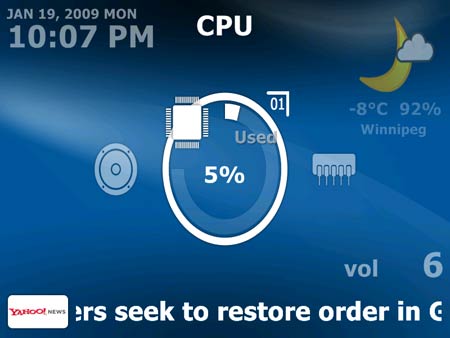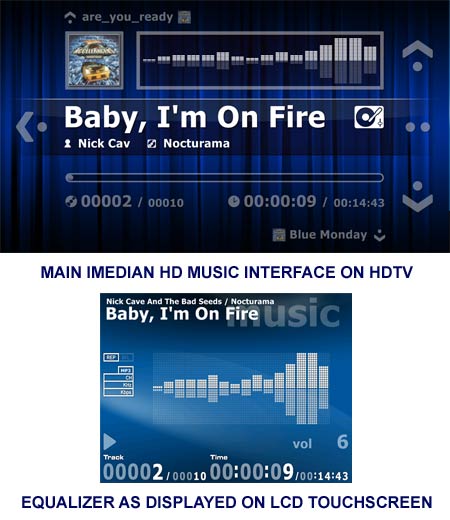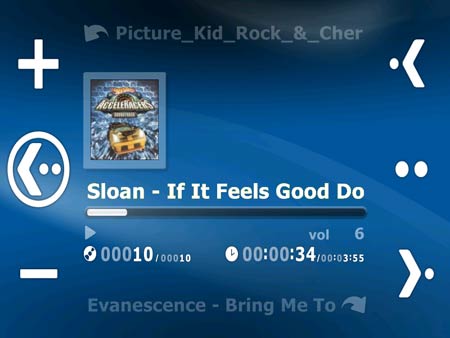HTPC Cases With LCD Screens: Bringing Bling
Real-Life Experience: Using A Touch-Screen LCD With An HTPC case
Using the Touch-Screen LCD
We've talked enough about getting everything to work. So now that it's running, what can the touch screen do?
When media is not being played, the Frontview application will display a lot of customizable information on the touch screen. Things like local weather, temperature, time, and news will be displayed. In addition, the screen will show information about the HTPC itself, such as data about the CPU, hard drive, and network usage.
The display really comes to life when playing music or video with either the iMedian HD or Vista Windows Media Center. Playing music or video with these applications will switch the LCD into media-information mode and will display information like file type, codec, length, and more. However, the graphical equalizer that shows you what you are hearing is more fun.


The display can also be used as an interface to media even when the main display is off or being used for something else. The Frontview Media Player can be controlled from the touch screen directly and used to launch music or video to view on the 7" LCD display. After launch, the LCD can still control volume and change media, even while playing video in the background.
Real-World Benefits of the Touch-Screen LCD
Let’s face it: the touch screens are really the core feature of these three HTPC cases. This is why their price is relatively high and it is what differentiates them from the competition. The touch screens certainly look very impressive and they add a notable amount of bling factor to the home-theater room.
Get Tom's Hardware's best news and in-depth reviews, straight to your inbox.
However, in real-world use we didn’t find them to be especially practical in most situations. Why get off the couch to use the touch screen if you have a remote control? In this sense, the touch screen is a definite step backward as far as a user interface tool goes. It’s certainly no killer app in this respect.
What about the visual component? The screen itself is nice, but how useful is it? Yes, it can display a movie, but why would you choose to watch a movie on a 7" screen when it is attached to your HDTV? Sure, the graphic equalizer is nice to have when playing music or a movie, but once again that’s firmly in the bling category and doesn’t offer any tangible utility.
The best practical use for the touch screen I can think of is for audio. In many cases, an HTPC might be connected to a large display such as a digital projector that the user wouldn’t want to turn on except when watching a movie. In this situation, the touch screen is perfect as a convenient interface to access your music library without wasting the projector bulb’s limited life. Or perhaps a user might want to leave the main LCD or plasma display off when playing music to save energy. Regardless, the ability to access music without having to turn on the main display is the most compelling functionality that the LCD touch screen offers.
Of course, while we have downplayed its usefulness, we can't ignore how the bling factor alone will attract many to invest in one of these cases. The LCD touch screens are certainly attractive and they'll definitely get noticed by your guests.
LCD Panel Comparison
Two of the three cases used identical LCD panels. The Thermaltake DH102 and Moneual 972 both used Soundgraph's 7" iMon OEM touch LCD, which is based on a Samsung 7" TFT LCD panel. Silverstone's CW03 used a Hitachi C100 7" LCD panel with similar specifications and an identical native resolution but it had a much higher maximum interpolated resolution:
| Screen: | Hitachi C100 7" LCD | Samsung 7" TFT LCD |
|---|---|---|
| Native Resolution | 800 x 480 | 800 x 480 |
| Maximum Resolution | 1920 x 1200 | 1024 x 768 |
| Brightness | 300 cd/mm | 350 cd/mm |
| Viewing Angle (L/R/U/D) | 65/65/45/61 | 65/65/50/60 |
| Response Time | 30 ms | 25 ms |
As you can see, the only difference of real note is the maximum interpolated resolution, and we can't think of a good reason to run the small 7" screen at 1920x1200 unless you wanted to interpolate the text down so small it would be completely unreadable. With everything else being so close to equal, we don't think the difference in LCD-screen quality is a factor worth considering when choosing between these three units.
Current page: Real-Life Experience: Using A Touch-Screen LCD With An HTPC case
Prev Page Touch-Screen Accessories: Soundgraph's iMedian HD, iMon Manager Software, And The iMon Remote Next Page Noise BenchmarksDon Woligroski was a former senior hardware editor for Tom's Hardware. He has covered a wide range of PC hardware topics, including CPUs, GPUs, system building, and emerging technologies.
-
Hamsterabed Nice Review, I agree with your take on cost but if i had the funds i would defiantly get one of these cases for an HTPC. the Moneual looks like the one I would get. This review was nice and balanced and took into all the different factors affecting the cases. noting that the screens were very similar and that the remotes were identical was something I was very happy to see as well as using the fan less psu as another control. A note of how the VGA cables get to the out side from the touch screen would have been a nice note but the pictures demonstrated it accurately showing that they have a pass through to the back video card area.Reply
A+ review in my book -
cruiseoveride ... and we're supposed to put these "hub caps" on my car?Reply
Seriously, this looks so cheap. Who is going to put it on a rack with $20k worth of audio/video equipment. -
average joe I like the rack mounting feature of the Silverstone. But I like the other case better. I think a rack would fit my sparse industrial theme.Reply
I have a fairly small space. Lots of Ikea furniture. -
DiscoDuck The touchscreen to me seems a bit of a waste. I prefer to use a standard computer monitor and a HDTV connected to a video card setup in a way that creates a workstation in the front wall of my hometheater with a slide out shelf for keyboard mouse. That way it can be a workstation/gaming machine from chair and HTPC from armchair via remote. I use mce2005.Reply -
JeanLuc Why would you want an expensive touch screen interface on HTPC? The whole point of having a HTPC is use can operate it remotely from your sofa. I would also like to have seen what motherboards these cases can support whether it be a micro ATX or full ATX motherboards.Reply -
cleeve Yeah, I have to agree with you fellows and I tried to get that across in the review; any productive use for these screens is a bit of a stretch. The only thing I could come up with is using the frontview media player to access music if you didn't want to power up your screen; I have a projector with a limited bulb life and I don't want to turn it on to listen to my music library.Reply
But thanks for reading it anyway, I hope the info was useful to you guys.
And thanks for the kind words, Hamsterabed! -
cleeve JeanLucI would also like to have seen what motherboards these cases can support whether it be a micro ATX or full ATX motherboards.Reply
I mentioned on the first page "All three offer full ATX compatibility", that includes MicroATX.
-
I have been waiting a long while for an updated HTPC review. I was hoping to see what kind of components you gurus would use, but this case review was very helpful to me too (been thinking about using an AMD GPU with the HDMI, but was interested in seeing some overall system power requirements of running an HTPC. Don't want a huge jump in electric bills). I was mostly considering building an HTPC for my dad. He's old, and likes to listen to music. He streams internet radio, but sits in the uncomfortable computer chair. With one of these cases he could easily select music AND be able to play a movie using the same box, without a learning curve that would frustrate him. Thanks for the write-up, I hope you can do another one soon!Reply
-
neodawg nice review, I have the DH101 which is the same - the 7in touch LCD, but it does have the remote and small 2x5 in blue black lcd, that displays computer/media information, i didnt find that the case was flimsy at all, maybe a little without the cover, but once the cover is on it is like a rock. I have to agree with you on the touch LCD, another good idea on paper, but in real world it is an epic fail.Reply -
cadder I've thought about this issue in the past and there are times when I might want to use the small screen and not power up the big screen-Reply
1) to set the PC to record something, say I get up in the morning and remember I wanted to record a certain broadcast, I can do that from the small screen
2) to take a quick look at the weather maybe
Actually I've thought about this with respect to just having a large screen and a small screen beside it, sort of the next step beyond "picture in picture". So maybe the touch screen aspect isn't useful but the screen itself might be useful, and if a person didn't want to use the touchscreen in the front of the case, they could use a small monitor or tv setting with the equipment. Some people might want the HTPC to set in the furniture along with the BluRay player and TV tuner, but others might have a more extensive setup with a place to sit and work, video games, multiple screens, etc.


